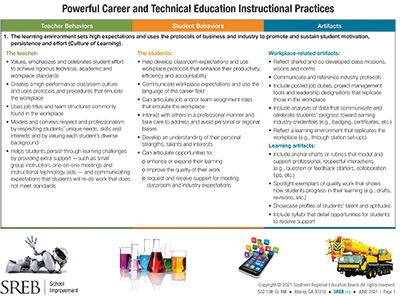Powerful CTE Instructional Practices
 This quick-reference guide presents
examples of teacher and student behaviors and learning artifacts
found in classrooms that embrace six Powerful Career and
Technical Education Instructional Practices. Teachers who embrace
these practices create high-quality learning experiences and
high-performance classrooms that motivate students to make the
effort needed to achieve rigorous technical, academic and
workplace standards.
This quick-reference guide presents
examples of teacher and student behaviors and learning artifacts
found in classrooms that embrace six Powerful Career and
Technical Education Instructional Practices. Teachers who embrace
these practices create high-quality learning experiences and
high-performance classrooms that motivate students to make the
effort needed to achieve rigorous technical, academic and
workplace standards.
- The learning environment sets high expectations and uses the
protocols of business and industry to promote and sustain student
motivation, persistence and effort (Culture of
Learning).
- Planned, authentic units of study and summative tasks align
with workforce expectations and allow students to demonstrate
their mastery of technical, academic and employability skills
(Plan with the End in Mind).
- Intentional collaborations with teachers, families and
business, industry, postsecondary and community partners enhance
the relevancy of lessons and assignments and promote students’
retention of the concepts, skills and competencies that are
valued in the workplace (Collaboration).
- Integration of relevant literacy, math and science concepts
and skills helps students deepen their understanding and transfer
skills across academic and technical disciplines and career
fields (Academic Integration).
- Opportunities to engage in experiential learning* using
industry-standard technology and equipment empower students to
apply what they learn in the classroom or lab to solve authentic
workplace problems (Experiential Learning).
- Rigorous assessments and learning activities allow students to receive feedback from teachers, peers and authentic audiences, engage in personal reflection and apply their understanding of academic, technical and workplace knowledge and skills to solve authentic problems (Assessment and Feedback).

